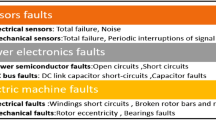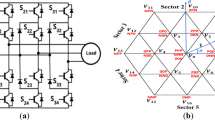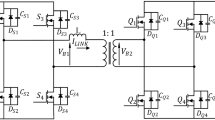Abstract
Low voltage ride through (LVRT) is one of the most popular methods to protect doubly fed induction generator (DFIG) against balanced and unbalanced voltage dips. In this study, a novel LVRT capability strategy is enhanced using forcing demagnetization controller (FDC) in DFIG-based wind farm. Moreover, not only stator circuit but also rotor circuit were developed by electromotor force (EMF) for LVRT in DFIG-based wind farm. The transient stability performances of the DFIG with and without the FDC and EMF were compared for three- and two-phase faults. In addition to variations such as 34.5 kV bus voltage and terminal voltage of DFIG, speed of DFIG, electrical torque of DFIG and d-q axis rotor-stator current variations of DFIG were also evaluated. It was seen that the system became stable within a short time using the FDC and EMF.





Similar content being viewed by others

References
Kyaw MM, Ramachandaramurthy VK (2011) Fault ride through and voltage regulation for grid connected wind turbine. Renew Energ 36:206–215
Sarkhanloo S, Yazdankhah MAS, Kazemzadeh R (2012) A new control strategy for small wind farm with capabilities of supplying required reactive power and transient stability improvement. Renew Energ 44:32–39
Mohseni M, Islam SM (2012) Transient control of DFIG-based wind power plants in compliance with the Australian grid code. IEEE Trans Power Electron 27(6):2813–2824
Xie D, Xu Z, Yang L, Ostergaard J, Xue Y, Wong KP (2013) A comprehensive LVRT control strategy for DFIG wind turbines with enhanced reactive power support. IEEE Trans Power Syst 28(3):3302–3310
Meegahapola LG, Littler T, Flynn D (2010) Decoupled-DFIG fault ride-through strategy for enhanced stability performance during grid faults. IEEE Trans Sust Energ 1(3):152–162
Hu S, Lin X, Kang Y, Zou X (2011) An improved low-voltage ride-through control strategy of doubly fed induction generator during grid faults. IEEE Trans Power Electron 26(12):3653–3665
Mohseni M, Masoum MA, Islam SM (2011) Low and high voltage ride-through of DFIG wind turbines using hybrid current controlled converters. Electr Power Syst Res 81(7):1456–1465
Ling Y, Xu C (2013) Rotor current dynamics of doubly fed induction generators during grid voltage dip and rise. Electr Power Energ Syst 44(1):17–24
Ling Y, Xu C, Ningbo W (2013) Rotor current transient analysis of DFIG-based wind turbines during symmetrical voltage faults. Energy Convers Manag 76:910–917
da Costa JP, Pinheiro H, Degner T, Arnold G (2011) Robust controller for DFIGs of grid-connected wind turbines. IEEE Trans Power Electron 58(9):4023–4038
Yang L, Xu Z, Ostergaard J, Dong ZY, Wong KP (2012) Advanced control strategy of DFIG wind turbines for power system fault ride through. IEEE Trans Power Syst 27(2):713–722
Rahimi M, Parniani M (2010) Grid-fault ride-through analysis and control of wind turbines with doubly fed induction generators. Electr Power Syst Res 80(2):184–196
Dai J, Xu D, Wu B, Zargari NR (2011) Unified DC-link current control for low-voltage ride-through in current-source-converter-based wind energy conversion systems. IEEE Trans Power Electron 26(1):288–297
Hossain MJ, Saha TK, Mithulananthan N, Pota HR (2013) Control strategies for augmenting LVRT capability of DFIGs in interconnected power systems. IEEE Trans Ind Electron 60(6):2510–2522
Xiao S, Yang G, Zhou H, Geng H (2013) An LVRT control strategy based on flux linkage tracking for DFIG-based WECS. IEEE Trans Ind Electron 60(7):2820–2832
Mohsen R, Parniani M (2010) Efficient control scheme of wind turbines with doubly fed induction generators for low voltage ride-through capability enhancement. IET Renew Power Gen 4(3):242–52
Döşoğlu MK (2016) A new approach for low voltage ride through capability in DFIG based wind farm. Int J Electr Power Energ Syst 83:251–258
Nguyen TDV, Fujita G (2012) Nonlinear control of DFIG under symmetrical voltage dips with demagnetizing current solution. In: IEEE international conference on in power system technology (POWERCON) pp 1–5
Linyuan Z, Jinjun L, Yangque Z, Sizhan Z (2012) Robust demagnetization control of doubly fed induction generator during grid faults. In: IEEE 7th international power electronics and motion control conference (IPEMC), June, pp 1446-1451
Zhou L, Liu J, Zhou S (2015) Improved demagnetization control of a doubly-fed induction generator under balanced grid fault. IEEE Trans Power Electron 30(12):6695–6705
Mokhtari M, Farrokh A (2014) Toward wide-area oscillation control through doubly-fed induction generator wind farms. IEEE Trans Power Syst 29(6):2985–2992
Knüppel T, Nielsen JN, Jensen KH, Dixon A, Østergaard J (2013) Power oscillation damping capabilities of wind power plant with full converter wind turbines considering its distributed and modular characteristics. IET Renew Power Gener 7(5):431–442
Leon AE, Solsona JA (2014) Power oscillation damping improvement by adding multiple wind farms to wide-area coordinating controls. IEEE Trans Power Syst 29(3):1356–1364
Molinas M, Suul JA, Undeland T (2008) Low voltage ride through of wind farms with cage generators: STATCOM versus SVC. IEEE Trans Power Electron 23(3):1104–1117
Kumar NS, Gokulakrishnan J (2011) Impact of FACTS controllers on the stability of power systems connected with doubly fed induction generators. Int J Electr Power Energ Syst 33(5):1172–1184
Amaris H, Alonso M (2011) Coordinated reactive power management in power networks with wind turbines and FACTS devices. Energ Convers Manag 52(7):2575–2586
Wu F, Zhang XP, Godfrey K, Ju P (2007) Small signal stability analysis and optimal control of a wind turbine with doubly fed induction generator. IET Gener Transm and Distrib 1(5):751–760
Ekanayake JB, Holdsworth L, Jenkins N (2003) Comparison of 5th order and 3rd order machine models for double fed induction generators (DFIG) wind turbines. Electr Power Syst Res 67(3):207–215
Lei Y, Mullane A, Lightbody G, Yacamini R (2006) Modeling of the wind turbine with a doubly fed induction generator for grid integration studies. IEEE Trans Energ Convers 21(1):257–264
Krause PC (2002) Analysis of electric machinery, 2nd edn. McGraw-Hill, New York
Lopez J, Sanchis P, Roboam X, Marroyo L (2007) Dynamic behavior of the doubly-fed induction generator during three-phase voltage dips. IEEE Trans Energ Convers 22(3):709–717
Liang J, Qiao W, Harley RG (2010) Feed-forward transient current control for low-voltage ride-through enhancement of DFIG wind turbines. IEEE Trans Energ Convers 25(3):836–843
García-Gracia M, Comech MP, Sallan J, Llombart A (2008) Modelling wind farms for grid disturbance studies. Renew Energ 33(9):2109–2121
Author information
Authors and Affiliations
Corresponding author
Rights and permissions
About this article
Cite this article
Döşoğlu, M.K., Güvenç, U., Sönmez, Y. et al. Enhancement of demagnetization control for low-voltage ride-through capability in DFIG-based wind farm. Electr Eng 100, 491–498 (2018). https://doi.org/10.1007/s00202-017-0522-6
Received:
Accepted:
Published:
Issue Date:
DOI: https://doi.org/10.1007/s00202-017-0522-6



